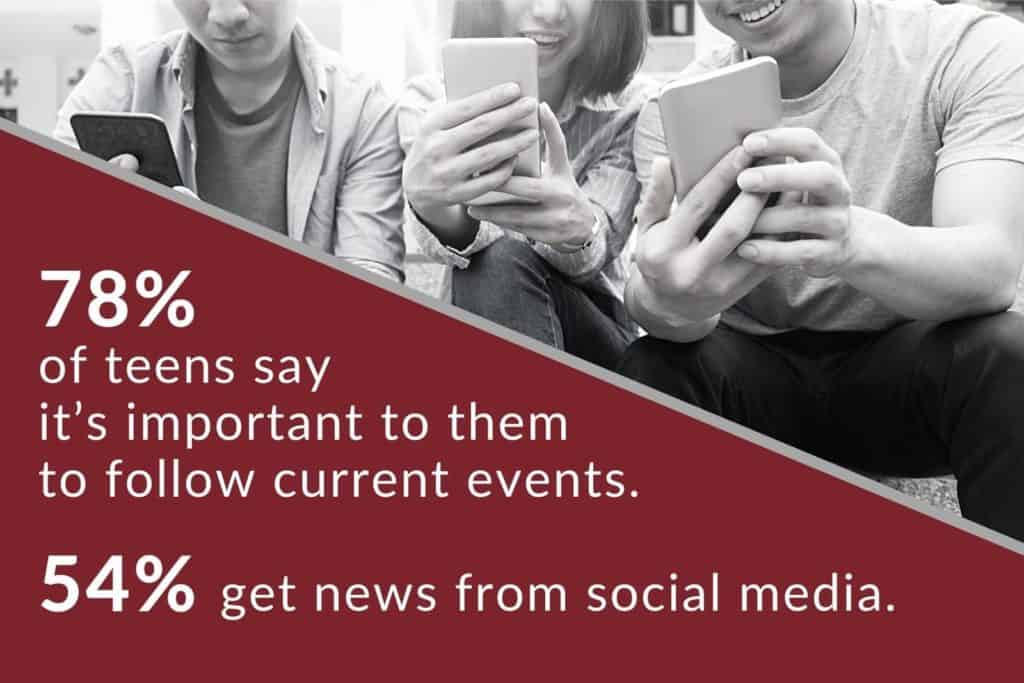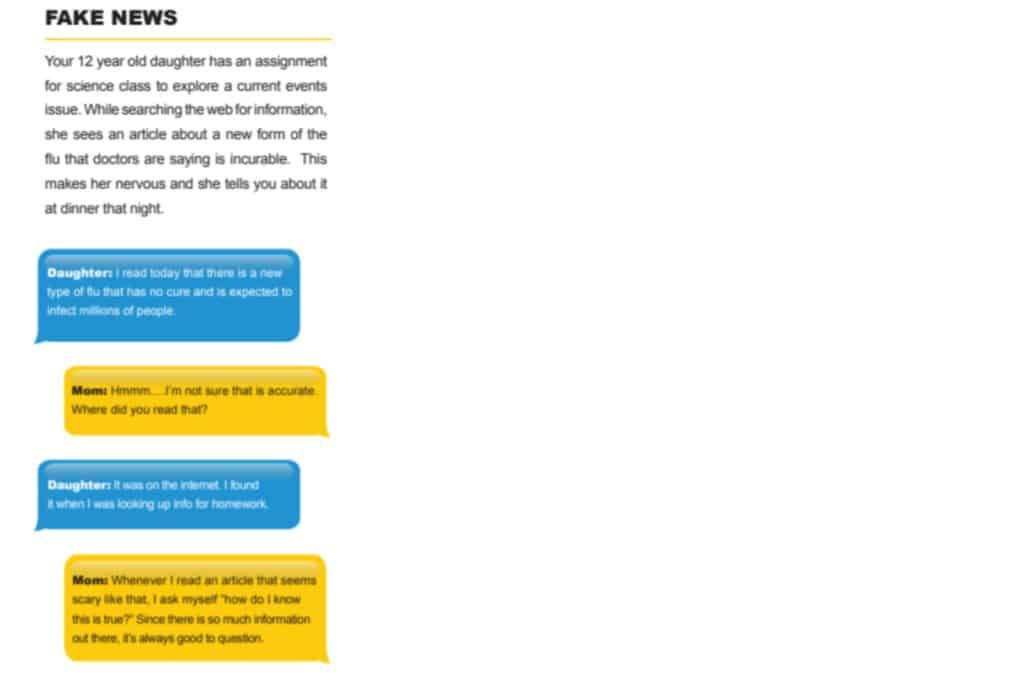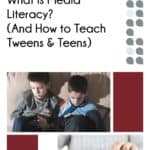What is Media Literacy (And How to Teach Tweens & Teens)

Learn “What is Media Literacy?” and ways to help our kids think critically about what they’re seeing in the news. There are simple ways for parents to be on top of news for teenagers and tweens.
This post contains affiliate links – we earn a small commission if you purchase through our links, and we appreciate your support.
If you ask me to say the first word that comes to mind when I think back on the year 2020, a whole list of options come to mind right away. Most of them are not very nice, to be fully transparent. But one of the most fitting words might just be “newsworthy.”
Let’s take a quick look at the highlights of 2020:
- A global pandemic swept the world
- Supreme Court Justice and feminist icon Ruth Bader Ginsberg died just weeks before the presidential election
- A highly controversial presidential election divided many Americans
- Protests, demonstrations and riots marked civil unrest with racial injustice
- Wildfires raged from Australia to California
- Several beloved celebrities died: Kobe Bryant, Chadwick Boseman, Eddie Van Halen
Oh. My.
That was the broad landscape, and then on top of that sat all the other things happening in our families and communities. Managing childcare with remote and hybrid school, dealing with sickness for our immediate or extended families, modifying or cancelling gathering/trips/events.
On top of everything else, we shouldered the responsibility as parents of helping our tweens process the things going in our communities and in the world around them.
And this didn’t end with the close of 2020. Parents still need to understand “What is media literacy?” and why it’s so important. Then we can teach our kids to seek out credible news as the basis for their actions and opinions.
What Is Media Literacy?
We’re talking more about news for teenagers or news for tweens. But solid media literacy is important for people of any age who are reading or hearing the news. Media literacy breaks down into the ability to do several things:
- Access media messages
- Evaluate media messages
- Analyze media messages
- Act on media messages
- Communicate media messages

In this post, we’re going to focus a whole lot on the evaluate and analyze aspects.
There are serious dangers when impressionable teens and tweens build opinions or take action based on faulty or biased information. It can lead to negative self-image or stereotypes about others and unnecessary worry, fear or anger.
Not to get all “when I was young, the world was different,” but our kids see and hear news in so many more ways in today’s world. It’s much harder to spot fake news. There’s also WAY more fake news now that anyone can publish information to the masses via social media.
News takes so many forms. From late night comedians to celebrity YouTubers to established news outlets putting strong slant into what used to be much more unbiased reporting.
As teachers at one of the largest universities in the U.S., Kristie and I teach hundreds of students a year. One of our colleagues who teaches journalism tells her students not to float through life like amoebas. She says to swim, with intention and eyes wide open.
I love that analogy. So I challenge my students to notice things and ask questions and think critically about what they see and hear. We should do the same with our tweens and teens at home.
What is media literacy?
Kids who actively verify the credibility of the sources they trust.
Kids who keep an eye out for bias and don’t automatically see all information that comes from media or social media as “truth.”
This is media literacy.
News for Teenagers and Tweens
Media literacy starts with having access to the news, and today’s kids have more access than any generation before them. Parents might be looking for news for teenagers or news for tweens when they’re already seeing and hearing news all around.

Where Do Tweens & Teens Get Their News
Teens primarily consume news on social media.
Common Sense Media surveyed more than 1,000 U.S. teens 13-17 about news for teenagers. Seventy-eight percent of teens say it’s important to them to follow current events. More than half (54%) get news from social media.
More than half of teens get news from YouTube at least a few times a week. They usually find it because it was recommended by YouTube as a “watch next” video or a sidebar.
When my 13-year-old son got TikTok, he said the same thing. He may not go to social media looking for news, but the “for you” page makes suggestions. He follows the ones that look interesting.
This means teens are often getting news from celebrities, influencers and other personalities rather than news organizations. The Common Sense survey shows that 60% of teens getting news on YouTube are getting it from celebrities or influencers rather than news organizations.
Tweens and teens get information from so many different sources. This makes it crucial that they learn how to judge the credibility of online information and find solid info.
Tweens and teens also need training on how to think critically about what they see. They need guidance on how to seek out multiple viewpoints on issues.
That’s where we can and should step in as parents to teach our kids media literacy.
How to Teach Our Tweens & Teens Media Literacy
It can feel tricky to guide tweens and teens when they’re really starting to seek independence and value what friends say more than parents. Below are eight simple ways to teach media literacy to your kids:
1. Stay Involved
The National Association for Media Literacy Education cautions parents not to back away from regulating their kids’ media consumption as they hit tween and teen years.
Tweens and teens naturally start to seek out independence and find their own identities during these years, but media shouldn’t be the only voice telling our kids who they should want to be.
Plenty of images online don’t give young people a healthy or realistic model, and parents can be a voice of reality and reason.
NAMLE offers a free Parent’s Guide to Media Literacy with information on helping kids build healthy relationships with media.
2. Help Tweens & Teens Identify Credible Sources
Share this short video from PBS news with your tweens and teens to let another young person tell them how to navigate social media news. She gives tips on what sources should be considered “green lights” and what warning flags indicate fake news or advertising that might appear to be actual news.
One tip we give our college students is that websites that end in .gov, .edu and .org often carry more weight and credibility than a .com.
NAMLE’s Parent’s Guide to Media Literacy also includes helpful examples of conversations I can easily imagine having with my tween and teen.

3. Teach the Art of Double-Checking
In its curriculum for middle and high school students, Common Sense Media uses a technique called lateral reading. This means encouraging kids to corroborate information they find with another source (or more).
We can suggest they look for a news item in multiple places to see if it is widely covered and also appears in trusted news outlets. If they find several articles on the same topic, they can compare the coverage on different sites and consider major differences in what information is provided.
When I asked my son what he does when he sees a news item he isn’t sure is true, he said he checks for other sources online or asks people in person. Good first step, but there are more conversations we need to have to make sure he’s questioning the right things and that it becomes the norm rather than the exception to think critically about what he’s seeing in different ways.
And now, with so many tweens and teens using ChatGPT and other AI tools, we need to keep reminding them about double checking information all the time.
4. Decode Fake News & Ads Disguised as News
Almost a quarter of adults have shared a false news story according to Media Smarts, a Canada-based center for digital and media literacy. Makes sense when we’re getting more and more news on social media.
People tend to ask fewer questions about credibility when we receive news from others they know.
We need to remind our tweens and teens (and ourselves) not to believe everything we read. Media Smarts offers an Authentication 101 tip sheet on how to recognize false information online.
It also helps to keep in mind that actual news is:
- Truthful: it deals with real events and facts
- Relevant: it’s something you need to know and care about
- Informative: it helps you understand a situation or issue and take action if relevant
- Timely: it’s current and useful
- Verifiable: it’s backed up by evidence
- Unbiased: it is not just the author’s opinion
These signposts for credible news appear in YouthLearn’s Media Literacy Toolkit. YouthLearn is part of the global nonprofit Education Development Center.
5. Encourage Questions & Reflection
It’s important to foster a mindset in our kids that all media requires critical thinking. When you’re watching or listening to media with your tween or teen, encourage them to ask:
- Who is the author or creator?
- Where are they from? (What organization? Which country?)
- What are their attitudes relative to my own?
- Are they trying to change my perspective in some way?
- What are they trying to achieve with this?
- Do I agree with their point of view?
- How can I respond?
- Who is the intended audience?
If it’s a national news item and you want to take it a step further, challenge your tween or teen to find coverage of the same story or subject from a local source. Then you can talk about how the subject is relevant locally or what looks different.
Ask if it feels more useful or informative. Have them try to find a story on the topic written by a teen and ask the same questions.
A few places to find articles written about and by teens:
- Teenagers in the Times, New York Times
- Teens, TIME magazine
- Teen Tribune, Smithsonian
- PBS News Hour Kids, PBS
6. Know What Makes News Newsy
I started my career as a journalist, so I’m in a position to really give my kids an earful about the 24/7 news cycle and news values. These aren’t things the average parent knows.
Media outlets choose news based on what they think their audience wants or needs to know most. To determine that, they use a combination of these news values:
- Timeliness – current events/information
- Proximity – it’s happening nearby
- Relevance – it impacts you
- Prominence – it involves known people
- Human Interest – it tugs on the heart strings in some way
- Conflict & Controversy – the tension between two sides or opinions draws you in
News values haven’t changed much over the years, but the internet now makes news a 24/7 business. The pressure on media outlets to provide timely and accurate information all day every day can jeopardize research and fact-checking even among credible news sources.
This printer-friendly news values worksheet from the PBS Student Reporting Lab gives more detail on news values.
7. Reinforce Family Values
As you discuss current events and other issues with your tweens and teens, bring your own family’s values into the conversation. We wrote a whole post about how to define your family’s values and why it’s such a game-changer for parents of tweens and teens.
Help your kids see how you filter what you see and read through the values you’ve chosen for your family. How your values impact your response to information in the media.
8. Use Politics as a Lesson in Media Literacy
Common Sense Media gives easy ways to talk to kids about politics and breaks them down for elementary through high school kids in ways that are developmentally appropriate.
For middle and high school students, they suggest:
- Talking about political ads and asking who paid for it and whether it’s “sales” or information.
- Finding some political movies to watch together to see how fiction matches up with real life.
- Looking at news together so you can discuss or explain complicated issues. See our post on how to talk to kids about mass shootings for more on this really tragic and tough topic.
- Watching debates together to explain terms your kids don’t know. Point out when candidates distract or go off topic. Talk about key campaign issues mentioned and ask if your teens can identify specific positions for each candidate.
- Making sure tweens and teens know how elections really work.
- Addressing any hate speech or fear mongering and separating it from positions on issues. Click here for more information specifically about how to talk to tweens and teens about racism.
- Discussing campaign issues that make national news (the more outrageous, the more likely to make headlines);
- Checking the credibility of candidates’ claims at the nonpartisan site FactCheck.org.
What are your biggest challenges in talking to your kids about current events and other things they’re seeing in the news?
Comment below or email me at msterenberg@salteffect.com.







